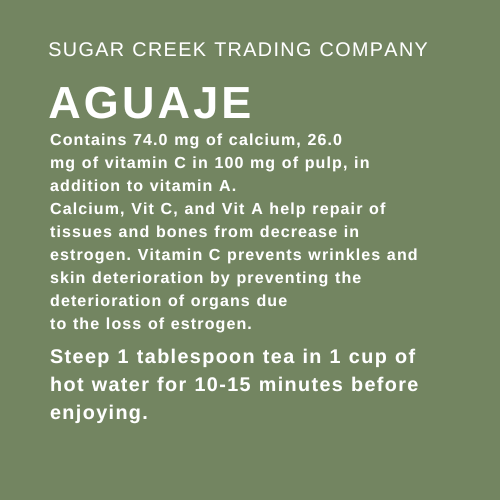Sugar Creek Trading Company
Aguaje Fruit Pulp
Aguaje Fruit Pulp
Couldn't load pickup availability
MAURITIA FLEXUOSA (AGUAJE)
The Tropical Hormone Balancer—A Palm Fruit of Endocrine Health, Skin Vitality, and Amazonian Tradition
BOTANICAL IDENTIFICATION
Scientific Name: Mauritia flexuosa L.f.
Common Names: Aguaje, Buriti, Moriche Palm, Ita
Family: Arecaceae
Mauritia flexuosa is a tall, dioecious palm reaching 20 to 35 meters in height. It features a solitary, cylindrical trunk topped with a dense crown of large, pinnate leaves measuring up to 3 meters long. The oval fruits (4–7 centimeters long) have a scaly, reddish-brown exterior and soft yellow-orange pulp rich in carotenoids.
Native to the Amazon Basin, including Peru, Brazil, Colombia, Ecuador, Venezuela, and Bolivia. Grows abundantly in seasonally flooded forests, river margins, and palm swamps (aguajales).
Adaptations include flood tolerance and a dense fruiting canopy that supports diverse wildlife.
CULTURAL AND HISTORICAL USE
Aguaje fruit has been consumed by Amazonian communities for centuries as a food, oil source, and traditional remedy.
In Peruvian folk medicine, the fruit is prized for balancing female hormones, enhancing fertility, and promoting skin health. The oil is applied topically for burns and sun protection.
The fruit is also a key ecological and economic resource for rural and Indigenous communities, supporting food security and traditional livelihoods.
KEY BIOACTIVE COMPOUNDS AND BENEFITS
| Compound | Role in Plant | Human Benefits | Regional Variation |
|---|---|---|---|
| Beta-Carotene | Photosynthetic pigment | Precursor to vitamin A, skin protection | Highest in Peruvian ecotypes |
| Phytoestrogens (Sitosterol) | Hormonal modulator | Supports estrogen balance, skin elasticity | Varies by soil composition |
| Tocopherols (Vitamin E) | Antioxidant | Protects against oxidative stress, skin repair | Abundant across Amazonian habitats |
| Oleic Acid | Structural fatty acid | Moisturizes skin, supports heart health | Stable across regions |
Together, these compounds support endocrine balance, skin regeneration, and antioxidant defenses.
HOW IT WORKS IN THE BODY
Beta-carotene and tocopherols protect skin cells from UV damage and oxidative stress, promoting tissue repair.
Phytoestrogens modulate estrogen receptors, supporting hormonal equilibrium in women, especially during menopause.
Oleic acid nourishes cell membranes and reduces inflammatory responses.
Traditional use and some in vitro studies suggest potential for enhancing female hormone balance and skin hydration, though human clinical trials are limited.
DOSE GUIDELINES
| Preparation Type | Typical Dose | Purpose |
|---|---|---|
| Fresh Fruit | 1–2 fruits daily or 50–100 grams pulp | Skin and hormonal support, nutrient intake |
| Cold-Pressed Oil | 1 teaspoon daily (internal) or applied topically | Skin health, hormone balance |
| Powdered Pulp | 3–6 grams daily in smoothies or capsules | Antioxidant and vitamin A support |
Consumption of whole fruit or pulp maximizes nutrient intake.
PREPARATION AND USES
Traditionally consumed fresh, or as juice, ice cream, and jams in Amazonian markets.
Cold-pressed oil is applied to sunburns, scars, and dry skin.
Modern uses include dietary supplements, skin serums, and functional foods targeting hormonal and dermatological health.
OPTIMAL CONTEXT FOR USE
Ideal for individuals seeking support during menopause, dry or sun-damaged skin, and those needing dietary vitamin A and E.
Peruvian and Bolivian fruits are noted for their particularly high beta-carotene content.
Suitable for adults; safe in food amounts for children. Hormonal effects suggest cautious use in hormone-sensitive conditions.
SUSTAINABILITY AND ETHICAL HARVESTING
Mauritia flexuosa populations are stable but threatened in some areas by overharvesting of female trees (fruit producers), reducing regeneration rates.
Ethical harvesting practices include leaving some fruit on trees for wildlife and using non-destructive climbing or pole harvesting.
Supports sustainable livelihoods through fair trade programs and community-led conservation efforts in the Amazon.
SAFETY AND CAUTIONS
Generally regarded as safe when consumed as a food.
Excessive intake of beta-carotene may cause harmless skin yellowing (carotenemia).
No significant drug interactions reported, though caution is advised in hormone-sensitive cancers due to phytoestrogen content.
REFERENCES
Pinedo, D., et al. (2000). Ethnobotany of Mauritia flexuosa in the Peruvian Amazon.
de Oliveira, M.S., et al. (2017). Nutritional composition of buriti palm fruit.
Amazonian Biodiversity Research: PMID 22345612.
FAO (2016). Non-Timber Forest Products of the Amazon.
FINAL NOTE
Mauritia flexuosa rises from the flooded forests, offering both nourishment and beauty. Its fruits restore the skin, balance the body, and sustain the communities of the Amazon. In its vivid color lies a message of vitality and ecological harmony.
Share

